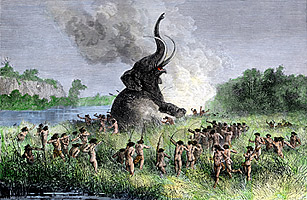
Most New Year’s resolutions have an awfully short shelf life. By the end of January, folks who swore they would lose weight and shape up may already be back on the Krispy Kremes. But that’s not entirely our fault, claims Arthur De Vany, a former economics professor at the University of California, Irvine. In his new book, The New Evolution Diet, De Vany argues if we really want to get fit, we should follow the lead of our ancient ancestors, Paleolithic humans who lived as nomadic hunter-gatherers some 40,000 years ago.
For more than 25 years, De Vany has been an advocate of what he calls “evolutionary fitness”: a regimen of low-carb eating and interval- or cross-training workouts aimed at controlling insulin. But he has also become the grandfather of the growing Paleo movement, a health philosophy built around the belief that modern life — dating from the advent of agriculture 10,000 years ago — is simply alien to our genes. Believers say that only by returning to a diet of wild game and fresh produce, eliminating grains and dairy, and exercising in short, intense bursts, can we thrive in a world of escalators and cheese fries.
There’s no doubt that something is way off about our collective health; rampant rates of obesity, heart disease and diabetes make that self-evident. And there’s no doubt that this is a direct result of our high-fat, high-calorie, sedentary lives. But is there something more authentically “human” about life in the Paleolithic — something that makes humans simply better adapted to an ancient diet and ancient exercise patterns? Not exactly.
For one thing, there was no single Paleolithic “lifestyle.” Survival in Ice Age Europe, for instance, was vastly different from life on the African savannah, requiring different diets, behaviors and genetic adaptations. For another, human DNA didn’t freeze in place at some mythical peak. In fact, we’re still evolving.
Human genetic adaptations actually increased around 40,000 years ago as we developed technology like the bow and arrow, broadened our food sources and became more sophisticated, cooperative thinkers. The pace really ramped up around 8,000 B.C. during the onset of agriculture. At least 3,000 significant genetic adaptations have occurred since, including the ability of some Africans, central Asians and northern Europeans to tolerate lactose as adults.